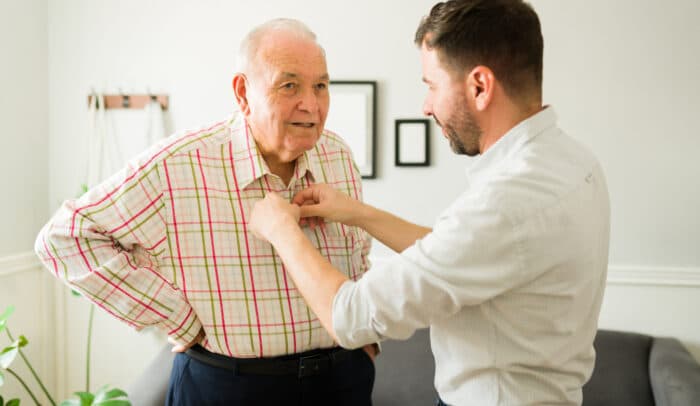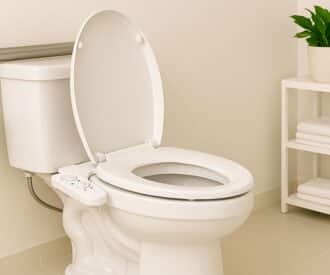
Many older adults live with chronic conditions or age-related changes that make everyday activities like getting dressed difficult, painful, or impossible to do independently. Joe & Bella shares 3 ways that adaptive clothing for seniors improves quality of life.
Adaptive clothing is designed for comfort and ease of dressing
With age, mobility and comfort become increasingly important when it comes to getting dressed.
Often, older adults are living with age-related changes that impact mobility and dexterity or a chronic condition that can impact their ability to dress.
Whether it’s Parkinson’s, ALS, dementia, or recovery from a stroke or medical procedure, there are many reasons why older adults would benefit from using adaptive clothing.
Traditional clothing can become challenging to put on, uncomfortable to wear for long periods, or potentially hazardous if it restricts movement or balance.
For older adults who experience these challenges, adaptive clothing can be a game-changer.
Adaptive clothing is designed with these specific needs in mind, making it safer, more comfortable, and easier to put on and take off clothes.
Adaptive clothing also comes in a variety of styles, from casual clothes to formal wear, so older adults can feel comfortable and confident no matter the occasion.
Here, we share 3 ways that adaptive clothing for seniors improves quality of life: improving mobility and comfort, maintaining independence and dignity, and improving health and safety.
1. Adaptive clothing improves senior mobility and comfort
For people with mobility limitations, getting dressed can be a frustrating and exhausting experience.
Traditional clothing often requires multiple steps, buttons, laces, and squeezing arms and head into small openings. This can be difficult to manage when mobility or dexterity is limited.
Adaptive clothing is designed with these challenges in mind, featuring easy-to-use fasteners and closures that make dressing much easier.
For example, some adaptive clothing has magnetic closures, which are helpful for people with arthritis, limited dexterity, tremors, and even limited vision. These types of closures allow them to easily fasten and unfasten clothing without struggling with buttons.
Comfort is also a significant concern for older adults, especially those with skin sensitivities or chronic conditions like arthritis.
Many traditional clothing items are made from materials that can be stiff, itchy, or restrictive, making them uncomfortable to wear for long periods.
Adaptive clothing is typically made from soft, flexible fabrics that promote ease of movement and prevent skin irritation.
2. Adaptive clothing maintains senior independence and dignity
Older adults who need help getting dressed may feel a loss of dignity and independence.
Adaptive clothing is designed to promote independence, making it easier for some people to dress themselves without assistance.
In addition, adaptive clothing can also help seniors maintain their sense of dignity.
Some adaptive clothing brands are designed both to fit properly and also to look stylish, so seniors can feel good about their appearance.
Being able to wear the clothes they like and have always worn is especially important to people who are living with dementia or other cognitive impairments.
This might be more important than you may think. There's also a psychological benefit to adaptive clothing.
When older adults wear clothing that they feel comfortable and confident in, it can do wonders for their self-esteem and mood.
Especially as older adults are forced to give up other aspects of their identity – their family home, being able to drive, and participating in many of their favorite activities – their clothes become an even more important way in which they show the world who they are.
3. Adaptive clothing improves senior health and safety
Adaptive clothing can also provide numerous health and safety benefits for older adults.
For example, well-fitting anti-slip footwear can help prevent falls by providing better grip and stability.
Open-back and side-opening garments can be easier to put on and take off, reducing the risk of injury or aggravating existing conditions.
Elastic waistbands and adjustable straps can accommodate weight fluctuations, preventing discomfort and skin irritation.
Adaptive clothing can also be designed to accommodate medical devices like feeding tubes, catheters, and incontinence products, without sacrificing style or comfort. This is especially important for seniors who require medical care on a daily basis.
Recommended for you:
- 10 Simple Dressing Aids Help Seniors Stay Independent
- 8 Arthritis Dressing Tips Make Life Easier for Seniors
- Adaptive Shoes for Seniors Increase Safety and Mobility
Guest contributor: Joe & Bella is the first contemporary adaptive-apparel brand for older adults. We make stylish, comfortable clothes that innovatively balance form and function, in turn making dressing easier, stress-free, and more dignified. Our mission is to bring more dignity, joy, and ease to the lives of older adults and those who care for them and – in doing so – helping older adults rediscover and express their identities through what they wear.
This article wasn’t sponsored and doesn’t contain affiliate links. For more information, see How We Make Money.
[optin-monster slug=”yxbytm35zhsdfopnw7qk”][optin-monster slug=”jvhyplxmb4umsjazxecn”]




